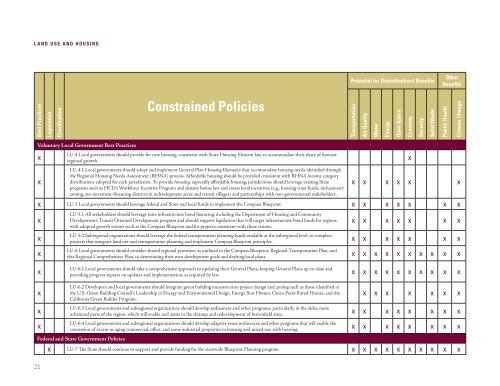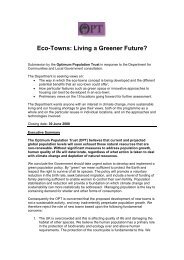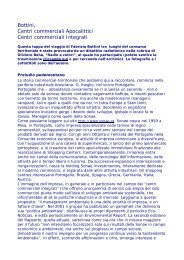Constrained Policies
Constrained Policies
Constrained Policies
You also want an ePaper? Increase the reach of your titles
YUMPU automatically turns print PDFs into web optimized ePapers that Google loves.
LAND USE AND HOUSINGPotential for Direct/Indirect BenefitsOtherBenefitsBest PracticesLegislationCoordination<strong>Constrained</strong> <strong>Policies</strong>TransportationAir QualityWaterEnergyOpen SpaceEconomySecuritySolid WastePublic HealthClimate ChangeVoluntary Local Government Best PracticesLU-4 Local governments should provide for new housing, consistent with State Housing Element law, to accommodate their share of forecastxregional growth.xLU-4.1 Local governments should adopt and implement General Plan Housing Elements that accommodate housing needs identified throughthe Regional Housing Needs Assessment (RHNA) process. Affordable housing should be provided consistent with RHNA income categorydistributions adopted for each jurisdiction. To provide housing, especially affordable housing, jurisdictions should leverage existing Stateprograms such as HCD’s Workforce Incentive Program and density bonus law and create local incentives (e.g., housing trust funds, inclusionaryzoning, tax-increment-financing districts in redevelopment areas and transit villages) and partnerships with non-governmental stakeholders.x x x x x xx LU-5 Local governments should leverage federal and State and local funds to implement the Compass Blueprint. x x x x x x xxxxLU-5.1 All stakeholders should leverage state infrastructure bond financing, including the Department of Housing and CommunityDevelopment’s Transit Oriented Development program and should support legislation that will target infrastructure bond funds for regionswith adopted growth visions such as the Compass Blueprint and for projects consistent with these visions.x x x x x x xLU-5.2 Subregional organizations should leverage the federal transportation planning funds available at the subregional level, to completeprojects that integrate land use and transportation planning and implement Compass Blueprint principles.x x x x x x xLU-6 Local governments should consider shared regional priorities, as outlined in the Compass Blueprint, Regional Transportation Plan, andthis Regional Comprehensive Plan, in determining their own development goals and drafting local plans.x x x x x x x x x xxxLU-6.1 Local governments should take a comprehensive approach to updating their General Plans, keeping General Plans up-to-date andproviding progress reports on updates and implementation, as required by law.x x x x x x x x x xxxx21LU-6.2 Developers and local governments should integrate green building measures into project design and zoning such as those identified inthe U.S. Green Building Council’s Leadership in Energy and Environmental Design, Energy Star Homes, Green Point Rated Homes, and theCalifornia Green Builder Program.x x x x x x xLU-6.3 Local governments and subregional organizations should develop ordinances and other programs, particularly in the older, moreurbanized parts of the region, which will enable and assist in the cleanup and redevelopment of brownfield sites.x x x x x x x xLU-6.4 Local governments and subregional organizations should develop adaptive reuse ordinances and other programs that will enable theconversion of vacant or aging commercial, office, and some industrial properties to housing and mixed-use with housing.x x x x x x x xFederal and State Government <strong>Policies</strong>x LU-7 The State should continue to support and provide funding for the statewide Blueprint Planning program. x x x x x x x x x x










